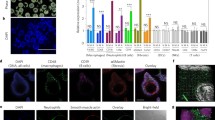Abstract
A method has been developed for thein vivo measurement of leucocyte chemotaxis in response to the bacterial chemotactic peptide F-met-leu-phe (FMLP). Polyurethane sponges were pre-treated with FMLP and implanted subcutaneously in rats and after a suitable interval removed for determination of leucocyte influx.In vivo concentration gradients of chemotactic factors within intact sponges were shallow and leucocyte accumulation unsatisfactory. Accordingly a cored sponge model was developed in which the cylindrical core only was treated with chemotactic factor and the sponge reassembled prior to subcutaneous implantation. Steep concentration gradients were established within the outer sponge matrix with marked effects on leucocyte accumulation, permitting studies of the time course ofin vivo chemotaxis. With cored sponges test to control cell number ratios were maximal at 4 hours using both free and albumin-bound FMLP. This model ofin vivo chemotaxis may prove useful in several areas of inflammation research.
Similar content being viewed by others
References
E. Schiffman,Leukocyte chemotaxis, Ann. Rev. Physiol.44, 553–568 (1982).
M. Di Rosa,Inhibition of cell migration in vivoand granuloma formation. InAnti-Inflammatory Drugs (EdsJ.R. Vane andS.H. Ferreira), Springer-Verlag, Berlin 1978.
K. Iwasaki andM. Torisu,Aniskis and eosinophil II. Eosinophilic phlegmon experimentally induced in normal rabbits by parasite-derived eosinophil chemotactic factor (ECF-P), Clin. Immunol. Immunopathol.23, 593–605 (1982).
A. W. Ford-Hutchison, J. R. Walker andM. J. H. Smith,Assessment of anti-inflammatory activity by sponge implantation techniques, J. Pharmac. Methods1, 3–7 (1978).
D. B. Myers, B. Vernon-Roberts andO. W. Weibkin,Collagen metabolism and proteoglycan aggregation in sponge-induced granulomas in rats, Proc. Univ. Otago Med. Sch.60, 12–13 (1982).
A. K. Clarke, B. Vernon-Roberts andH. L. F. Currey,Assessment of anti-inflammatory drugs in the rat using subcutaneous implants of polyurethane foam impregnanted with dead tubercle bacilli, Ann. Rheum. Dis.34, 326–331 (1975).
J. M. Lackie andA. F. Brown,Adhesion and the locomotion of neutrophils on surfaces and in matrices, Agents and ActionsSuppl 12, 73–90 (1982).
R. B. Gilbertsen, G. W. Carter andD. J. Quinn,Effects of F-Met-Leu-Phe and zymosan-activated serum on rat neutrophils in vivo, J. Reticuloendothel. Soc.27, 485–494 (1980).
T. L. Goodfriend, L. Levine andD. G. Fasman,Antibodies to bradykinin and angiotensin: a use of carbodiimides in immunology, Science144, 1344–1346 (1964).
W. A. Marasco, H. J. Showell, R. J. Freer andE. L. Becker.Anti-f- Met-Leu-Phe: similarities in fine specificity with the formyl peptide chemotaxis receptor of the neturophil, J. Immunol.128, 956–962 (1982).
W. S. Ramsay,Analysis of individual leucocyte behaviour during chemotaxis, Exp. Cell Research70, 129–139 (1972).
M. McCutcheon,Studies on the locomotion of leukocytes. I. The normal rate of locomotion of human neutrophilic leukocytes in vitro, Am. J. Physiol.66, 180–190 (1923).
J. I. Gallin, B. E. Seligman andM. P. Fletcher,Dynamics of human neutrophil receptors for the chemoattractant f-MET-LEU-PHE, Agents and ActionsSuppl 12, 290–308 (1982).
S. L. Wiener, R. Wierner, M. Uriretzky, S. Shafter, D. H. Isenberg, C. Janov andE. Meilman,The mechanism of action of a single dose of methyl prednisolone on acute inflammation in vivo, J. Clin. Invest.56, 679–689 (1975).
P. C. Wilkinson andR. B. Allan,Chemotaxis of neutrophil leucocytes towards substratum-bound protein attractants, Exp. Cell Res.117, 403–412 (1978).
H. J. Showell, P. H. Naccache, R. I. Sha'afi andE. L. Becker,Inhibition of rabbit neutrophil lysosomal enzyme secretion, non-stimulated and chemotactic factor stimulated locomotion by nordihydroguaiaretic acid, Life Sci.27, 421–426 (1980).
K. M. Skubitz, P. R. Craddock, D. E. Hammerschmidt andJ. T. August,Corticosteroids block binding of chemotactic peptide to its receptor on granulocytes and cause disaggregation of granulocyte aggregates in vitro, J. Clin. Invest.68, 13–20 (1981).
R. J. Smith andS. S. Iden,Pharmacological modulation of chemotactic factor-elicited release of granuleassociated enzymes from human neutrophils. Biochem. Pharmacol.29, 2389–2395 (1980).
Author information
Authors and Affiliations
Rights and permissions
About this article
Cite this article
Mellor, D.M., Myers, D.B. & Chadwick, V.S. The cored sponge model ofin vivo leucocyte chemotaxis. Agents and Actions 18, 550–554 (1986). https://doi.org/10.1007/BF01964963
Received:
Accepted:
Issue Date:
DOI: https://doi.org/10.1007/BF01964963




